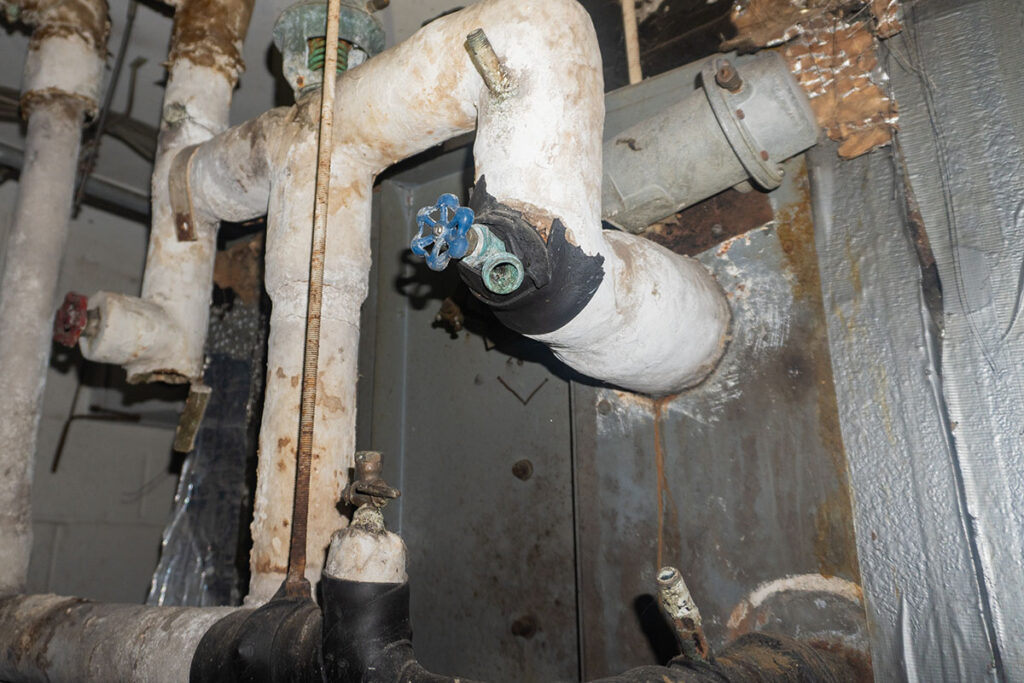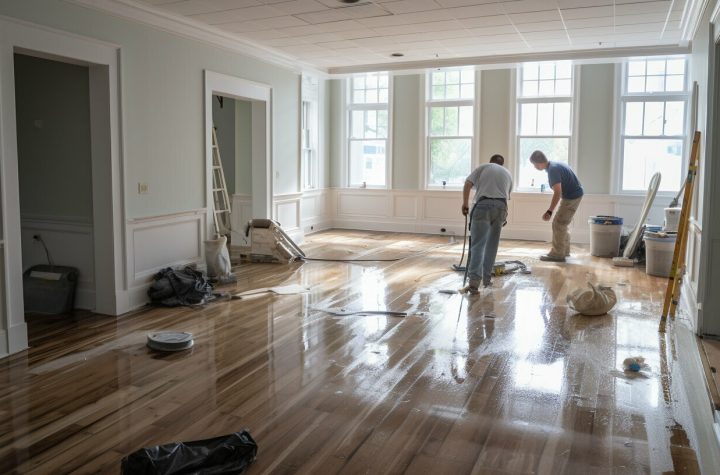
Photo of a valve on elbow of asbestos insulated pipe in a mechanical room.
Historical Use of Asbestos in Naval Ships
Asbestos was widely used in naval ships for many years due to its heat resistance and durability. This material was commonly found in:
- Insulation for pipes and boilers
- Fireproofing materials in engine rooms
- Deck coverings and other construction materials
The use of asbestos was prevalent until the late 20th century when its health risks became more widely recognized.
Common Areas of Asbestos Exposure on Ships
Navy personnel were often exposed to asbestos in specific areas of the ship, including:
- Engine rooms, where high temperatures made insulation necessary
- Boiler rooms, where asbestos was used to prevent fires
- Living quarters, where asbestos-containing materials were used in construction
These areas posed significant risks to sailors and workers who spent long hours in close proximity to asbestos.
Health Risks Associated with Naval Asbestos
Exposure to asbestos can lead to serious health issues, including:
- Asbestosis: A chronic lung disease caused by inhaling asbestos fibers.
- Mesothelioma: A rare cancer that affects the lining of the lungs and abdomen.
- Lung cancer: Increased risk for those exposed to asbestos over time.
Understanding these risks is crucial for veterans who may have been exposed during their service.
Transitioning from Naval to Home Asbestos Risks
Bringing Asbestos Fibers Home
Navy veterans may unknowingly carry asbestos fibers from their ships to their homes. This can happen in several ways:
- Clothing and Gear: Asbestos can cling to uniforms, boots, and other gear worn on ships.
- Personal Items: Tools and equipment used on naval vessels may also contain asbestos.
- Dust and Particles: Asbestos dust can settle on skin and hair, making it easy to transfer to home environments.
Secondary Exposure to Family Members
When veterans bring asbestos fibers home, their family members may also be at risk. This secondary exposure can occur through:
- Direct Contact: Family members may come into contact with contaminated clothing or gear.
- Household Dust: Asbestos fibers can become part of the household dust, affecting everyone in the home.
- Shared Spaces: Common areas like living rooms and bathrooms can harbor asbestos particles, increasing exposure risk.
Long-Term Health Implications
The health risks associated with asbestos exposure can be severe and long-lasting. Some potential health issues include:
- Respiratory Problems: Chronic coughing and difficulty breathing can develop over time.
- Cancer Risks: Prolonged exposure increases the likelihood of developing asbestos-related cancers, such as mesothelioma.
- Other Health Conditions: Veterans and their families may face various chronic health issues linked to asbestos exposure.
Identifying Asbestos in the Home
Common Household Items Containing Asbestos
Asbestos can be found in various household items, especially in homes built before the 1980s. Some common items include:
- Insulation materials: Often used in attics and walls.
- Floor tiles: Some vinyl tiles and the adhesive used to install them may contain asbestos.
- Roofing materials: Shingles and other roofing products can have asbestos fibers.
Signs of Asbestos Contamination
Recognizing signs of asbestos contamination is crucial for safety. Look for:
- Damaged materials: Cracked or crumbling insulation or tiles.
- Dust: Unusual dust in areas where asbestos materials are present.
- Age of the home: Homes built before the 1980s are more likely to contain asbestos.
Professional Asbestos Inspections
If there is a suspicion of asbestos in the home, it is important to seek professional help. Steps to take include:
- Hire a certified inspector: Look for professionals who specialize in asbestos testing.
- Conduct testing: The inspector will take samples and send them to a lab for analysis.
- Follow recommendations: Based on the results, the inspector will advise on the next steps, which may include removal or containment.
Health Effects of Asbestos Exposure
Respiratory Issues
Asbestos exposure can lead to serious breathing problems. Some common respiratory issues include:
- Asbestosis: A chronic lung disease caused by inhaling asbestos fibers, leading to scarring of lung tissue.
- Chronic Obstructive Pulmonary Disease (COPD): A group of lung diseases that block airflow and make it hard to breathe.
- Pleural Disease: Changes in the lining of the lungs, which can cause pain and difficulty breathing.
Asbestos-Related Cancers
Exposure to asbestos is linked to several types of cancer, including:
- Mesothelioma: A rare cancer that affects the lining of the lungs, abdomen, or heart.
- Lung Cancer: A common cancer that can develop from long-term exposure to asbestos.
- Other Cancers: There is also evidence linking asbestos to cancers of the larynx, ovary, and gastrointestinal tract.
Chronic Health Conditions
In addition to respiratory issues and cancers, asbestos exposure can lead to other long-term health problems:
- Autoimmune Diseases: Conditions where the immune system attacks the body’s own cells.
- Cardiovascular Issues: Heart problems that may arise from chronic lung disease.
- Mental Health Effects: Anxiety and depression can occur due to the stress of dealing with serious health issues.
Legal Rights and Resources for Navy Veterans
Veterans’ Benefits for Asbestos Exposure
Navy veterans who have been exposed to asbestos may be eligible for various benefits. These benefits can help cover medical expenses and provide financial support. Key benefits include:
- Disability Compensation: Monthly payments for veterans with service-related disabilities.
- Health Care Services: Access to medical care through the Department of Veterans Affairs (VA).
- Vocational Rehabilitation: Support for veterans to find suitable employment if they are unable to work due to health issues.
Filing Asbestos-Related Claims
Veterans can file claims for asbestos exposure through the VA. The process generally involves:
- Gathering Evidence: Collect medical records and service documents that show exposure.
- Submitting a Claim: Fill out the necessary forms and submit them to the VA.
- Awaiting a Decision: The VA will review the claim and notify the veteran of the outcome.
Legal Assistance and Support Groups
Veterans seeking help with asbestos-related issues can find support through various organizations. These resources include:
- Legal Aid Services: Free or low-cost legal help for veterans navigating claims.
- Support Groups: Communities where veterans can share experiences and advice.
- Veterans’ Organizations: Groups that advocate for veterans’ rights and provide information on available resources.
Preventive Measures for Asbestos Exposure
Safety Protocols on Naval Ships
To protect sailors from asbestos exposure, naval ships have implemented several safety protocols. These include:
- Regular Training: Crew members receive training on how to identify and handle asbestos safely.
- Personal Protective Equipment (PPE): Sailors are provided with protective gear, such as masks and suits, to minimize exposure.
- Controlled Access: Areas known to contain asbestos are restricted to authorized personnel only.
Home Asbestos Abatement Procedures
When dealing with asbestos in homes, it is crucial to follow proper abatement procedures:
- Professional Assessment: Always hire a certified professional to inspect and assess the presence of asbestos.
- Safe Removal: If asbestos is found, it should be removed by trained experts to ensure safety.
- Proper Disposal: Asbestos waste must be disposed of according to local regulations to prevent contamination.
Protective Gear and Equipment
Using the right protective gear is essential for anyone working in environments with potential asbestos exposure:
- Respirators: High-efficiency masks should be worn to filter out asbestos fibers.
- Coveralls: Disposable coveralls can help prevent fibers from sticking to clothing.
- Gloves: Heavy-duty gloves should be used to protect hands during any handling of materials that may contain asbestos.
Case Studies of Affected Navy Veterans
Personal Stories of Asbestos Exposure
Many Navy veterans have shared their experiences with asbestos exposure during their service. These stories highlight the dangers they faced:
- Ship Maintenance: Veterans often worked in tight spaces where asbestos was used for insulation. They reported breathing in dust while repairing pipes and boilers.
- Living Quarters: Some veterans lived in areas where asbestos was present, leading to long-term exposure. They recall feeling unwell but not knowing the cause.
- Training Exercises: During training, veterans were sometimes exposed to materials containing asbestos, which they later learned could be harmful.
Medical Case Studies
Research has documented various health issues among veterans exposed to asbestos. Key findings include:
- Lung Diseases: Many veterans developed respiratory problems, such as asthma and chronic bronchitis, linked to asbestos exposure.
- Cancer Cases: Some veterans were diagnosed with mesothelioma, a rare cancer directly associated with asbestos.
- Long-Term Health Effects: Studies show that veterans face a higher risk of developing serious health conditions years after exposure.
Impact on Veterans’ Families
The effects of asbestos exposure extend beyond the veterans themselves. Families have also been affected:
- Secondary Exposure: Family members may have inhaled asbestos fibers brought home on clothing or equipment.
- Health Risks: Some spouses and children of veterans have reported health issues, raising concerns about the impact of asbestos on their lives.
- Emotional Toll: The stress of dealing with health problems has affected family dynamics, leading to emotional and financial challenges.
Government and Military Response to Asbestos Risks
Regulations and Policies
The government and military have established several rules to manage asbestos risks. These include:
- Bans on New Asbestos Use: New uses of asbestos in construction and shipbuilding are prohibited.
- Safety Standards: Guidelines are set to ensure safe handling and removal of asbestos materials.
- Monitoring Programs: Regular checks are conducted to ensure compliance with safety regulations.
Asbestos Removal Programs
To protect veterans and active service members, various asbestos removal initiatives have been launched, such as:
- Funding for Removal: Financial support is provided for the safe removal of asbestos from military facilities.
- Training for Workers: Workers are trained on how to safely handle and remove asbestos.
- Public Awareness Campaigns: Information is shared to educate the public about the dangers of asbestos exposure.
Support for Affected Veterans
Veterans who have been exposed to asbestos can access several forms of support, including:
- Health Care Services: Specialized medical care is available for asbestos-related health issues.
- Financial Assistance: Veterans may receive compensation for health problems linked to asbestos exposure.
- Legal Aid: Resources are available to help veterans navigate legal claims related to asbestos exposure.
The Role of Asbestos in Naval Shipbuilding
Historical Context of Asbestos Use
Asbestos was widely used in naval shipbuilding for many decades. This material was favored for several reasons:
- Fire Resistance: Asbestos can withstand high temperatures, making it ideal for protecting ships from fire hazards.
- Insulation Properties: It provided excellent insulation, helping to keep machinery and living quarters at comfortable temperatures.
- Durability: Asbestos is strong and resistant to wear, which made it suitable for various ship components.
Changes in Shipbuilding Practices
Over time, the use of asbestos in shipbuilding has changed significantly due to health concerns. Key changes include:
- Regulatory Changes: New laws have been introduced to limit or ban the use of asbestos in shipbuilding.
- Material Alternatives: Shipbuilders have started using safer materials that do not pose health risks.
- Increased Awareness: There is now a greater understanding of the dangers of asbestos, leading to more cautious practices.
Current Asbestos Regulations
Today, strict regulations govern the use of asbestos in naval shipbuilding. These regulations include:
- Mandatory Inspections: Ships must be inspected for asbestos before construction or renovation.
- Safe Removal Procedures: If asbestos is found, there are specific guidelines for its safe removal to protect workers and the environment.
- Training Requirements: Workers must receive training on how to handle asbestos safely and recognize its presence.
Asbestos Awareness and Education
Training Programs for Navy Personnel
To ensure the safety of Navy personnel, various training programs have been established. These programs aim to educate service members about the dangers of asbestos and how to handle it safely. Key components of these training programs include:
- Understanding Asbestos: Learning what asbestos is and where it can be found.
- Health Risks: Gaining knowledge about the health issues linked to asbestos exposure.
- Safety Procedures: Training on how to safely work in environments where asbestos may be present.
Public Awareness Campaigns
Public awareness campaigns play a crucial role in informing the community about asbestos risks. These campaigns often focus on:
- Spreading Information: Distributing flyers, brochures, and online content to raise awareness.
- Community Events: Organizing workshops and seminars to educate the public.
- Collaboration with Organizations: Partnering with health organizations to reach a wider audience.
Educational Resources for Veterans
Veterans have access to various educational resources to help them understand asbestos exposure. These resources include:
- Informational Booklets: Providing detailed information about asbestos and its effects.
- Online Courses: Offering courses that veterans can take at their own pace.
- Support Groups: Creating spaces for veterans to share experiences and learn from each other.
Medical Screening and Treatment Options
Early Detection of Asbestos-Related Diseases
Early detection of diseases caused by asbestos exposure is crucial for effective treatment. Regular medical check-ups can help identify issues before they become serious. Here are some key points to consider:
- Routine Screenings: Veterans should have regular lung function tests and chest X-rays to monitor their health.
- Symptom Awareness: Being aware of symptoms like persistent cough, chest pain, or shortness of breath can lead to quicker diagnosis.
- Specialist Consultations: Consulting with a pulmonologist or oncologist can provide tailored care and treatment options.
Treatment Facilities for Veterans
Veterans have access to various treatment facilities that specialize in asbestos-related health issues. These facilities offer comprehensive care, including:
- Veterans Affairs Hospitals: Many VA hospitals have programs specifically for veterans exposed to asbestos.
- Specialized Clinics: Some clinics focus on respiratory diseases and can provide advanced treatment options.
- Support Services: Facilities often offer counseling and support groups to help veterans cope with their conditions.
Innovative Medical Research
Research is ongoing to find better ways to treat diseases caused by asbestos exposure. Some areas of focus include:
- New Treatment Methods: Scientists are exploring new drugs and therapies to improve patient outcomes.
- Clinical Trials: Veterans may have the opportunity to participate in clinical trials for cutting-edge treatments.
- Preventive Strategies: Research is also aimed at developing strategies to prevent diseases related to asbestos exposure.






More Stories
Breathe Easy: Top Air Purifiers That Actually Beat Wildfire Smoke
The Hidden Costs of Not Paying Attention to Your Rain Gutters
Role Of Technology In Commercial Damage Restoration